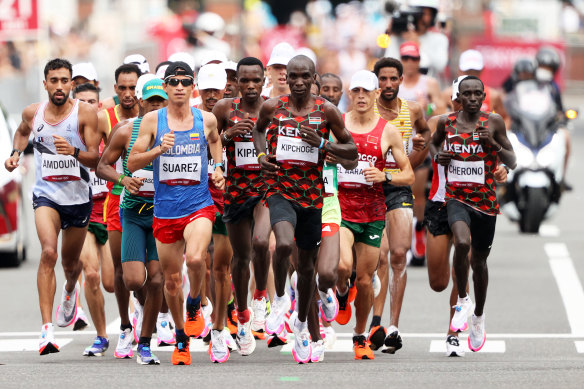Why humans are such good long-distance runners, according to science
By Joel Achenbach
The athletics events at the Paris Olympics officially kicked off last week, and some very fast people – blazingly, blindingly, thrillingly fast – have been vying for gold.
Anyone who has watched Olympic-class sprinters can only marvel at their explosive speed out of the blocks, their ability to find an extra gear and attain velocities that most of us can achieve only with the assistance of an internal combustion engine. Yesterday, American sprinter Noah Lyles won a gold medal by running 100m in 9.79 seconds.
But here’s what scientists will tell you: humans are actually kind of slow compared to many animals.
What humans are remarkably good at, however, is “endurance running”. As in, the marathon.

Eliud Kipchoge (centre) competes in the men’s marathon at the Tokyo 2020 Olympic Games. Kipchoge won the race with a time of 2:08:38.Credit: Getty Images
Scientists over the past four decades have debated why humans are so well put together for running long distances. One idea continues to drive the conversation: the “endurance pursuit hypothesis”.
The gist of the idea is that the physiological features that enable long-distance running are evolutionary adaptations that increased the ability of our prehistoric ancestors to pursue animals and overtake them when the animals became exhausted. Yes, a deer can sprint faster than a person, but tuckers out relatively quickly. A fit human being can overtake a deer over long distances.
The latest boost to the hypothesis emerged in May with the publication of a study in the journal Nature Human Behaviour. The authors claim two new lines of evidence that support the endurance pursuit idea.
First, their calculations suggest that it is energetically efficient to run rather than walk long distances in pursuit of game. Then they tackled one of the key objections to the hypothesis: the scarce evidence that people in hunter-gatherer societies actually did this kind of endurance pursuit. The researchers spent years digging through historical archives, including accounts as early as the 1500s, and found abundant accounts of the practice. The authors compiled a database of nearly 400 examples in 272 locations across the planet.
The invention and widespread dispersal of rifles, starting in the 1800s, probably suppressed this form of hunting, says Eugene Morin, an anthropologist at Trent University in Canada and a co-author of the new report.
We have physical features that are unusual or unknown in the rest of the animal kingdom, including abundant sweat glands, relatively little body hair, arched soles and springlike Achilles tendons. We have an abundance of slow-twitch fibres that are efficient for endurance pursuits. (Fast-twitch muscles are better for sprinting.)
The debate is hardly settled. What’s not firmly established is whether these anatomical features emerged through natural selection to enhance the ability to run long distances. They may also have aided walking, says Nicholas Holowka, a biological anthropologist at the University of Buffalo and expert on the evolution of bipedalism.
The challenge is “finding anatomical features that are clearly advantageous for running but don’t in some way also enhance walking,” says Holowka, who was not involved in the new research.
The new research drew praise from Daniel Lieberman, a Harvard professor of human evolutionary biology who is a leading proponent of the endurance pursuit hypothesis. He points out that a horse can run three times as fast as the fastest human, but a human can beat horses in a marathon – something he’s done himself.
“The problem is those animals run out of gas,” Lieberman says.
Among the many adaptations in humans is a large butt. The gluteus maximus muscle fires when we run and it stabilises our body and keeps us from falling on our face, Lieberman says.
And then there’s the great gift of perspiration.
Humans are unusually adept at dissipating heat through sweat glands all over the body. The lack of body hair (relative to other mammals) or fur makes it easier for sweat to evaporate. Our ancestors may have hunted during the heat of the day, when prey animals were most prone to heat exhaustion, and when many of the most dangerous animals, like the big cats, were chilling in the shade.
“A marathon runner can sweat up to about 4 litres per hour. That’s a lot,” Morin says. “We have a naked skin, which is unusual for mammals.”
A dog, Lieberman points out, can only cool by panting.
“We are the world’s champion sweaters,” Lieberman says. “By having sweat glands all over our bodies and by losing fur, we have essentially transformed our entire bodies into tongues.”
Washington Post
Make the most of your health, relationships, fitness and nutrition with our Live Well newsletter. Get it in your inbox every Monday.